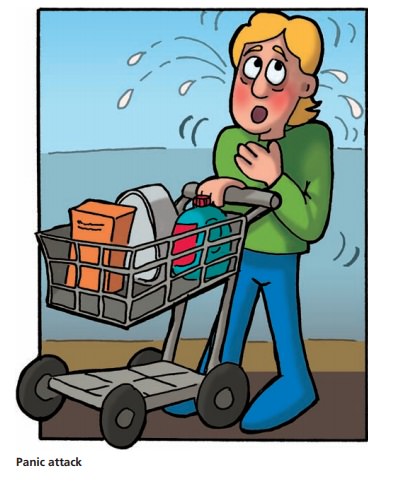Chapter: Psychiatric Mental Health Nursing : Anxiety, Anxiety Disorders, and Stress-Related Illness
Panic Disorder
PANIC DISORDER
Panic disorder is composed of discrete
episodes of panic attacks, that is,
15 to 30 minutes of rapid, intense, escalat-ing anxiety in which the person
experiences great emo-tional fear as well as physiologic discomfort. During a
panic attack, the person has overwhelmingly intense anxi-ety and displays four
or more of the following symptoms: palpitations, sweating, tremors, shortness
of breath, sense of suffocation, chest pain, nausea, abdominal distress,
diz-ziness, paresthesias, chills, or hot flashes.

Panic disorder is diagnosed when the person has recurrent,
unexpected panic attacks followed by at least 1 month of persistent concern or
worry about future attacks or their meaning or a significant behavioral change
related to them. Slightly more than 75% of people with panic disorder have
spontaneous initial attacks with no environmental trigger. Half of those with
panic disorder have accompanying agoraphobia. Panic disorder is more common in
people who have not graduated from college and are not married. The risk
increases by 18% in people with depression (Merikangas, 2005).
Clinical Course
The onset of panic disorder peaks in late adolescence and the
mid-30s. Although panic anxiety
might be normal in someone experiencing a life-threatening situation, a person
with panic disorder experiences these emotional and physi-ologic responses
without this stimulus. The memory of the panic attack coupled with the fear of
having more can lead to avoidance
behavior. In some cases, the person becomes homebound or stays in a limited
area near home such as on the block or within town limits. This behavior is
known as agoraphobia (“fear of the
marketplace” or fear of being outside).
Some people with agoraphobia fear stepping out-side the front door because a
panic attack may occur as soon as they leave the house. Others can leave the
house but feel safe from the anticipatory fear of having a panic attack only
within a limited area. Agoraphobia also can occur alone without panic attacks.
The behavior patterns of people with agoraphobia clearly
demonstrate the concepts of primary and second-ary gain associated with many
anxiety disorders. Primary gain is the relief of anxiety achieved
by performing the specific
anxiety-driven behavior such as staying in the house to avoid the anxiety of
leaving a safe place. Second-ary gain is
the attention received from others as a result of these behaviors. For instance, the person with agorapho-bia may
receive attention and caring concern from family members, who also assume all
the responsibilities of family life outside the home (e.g., work and shopping).
Essentially, these compassionate significant others become enablers of the
self-imprisonment of the person with agoraphobia.
Treatment
Panic disorder is treated with cognitive–behavioral tech-niques,
deep breathing and relaxation, and medications such as benzodiazepines, SSRI
antidepressants, tricyclic antidepressants, and antihypertensives such as
clonidine (Catapres) and propranolol (Inderal).
Related Topics